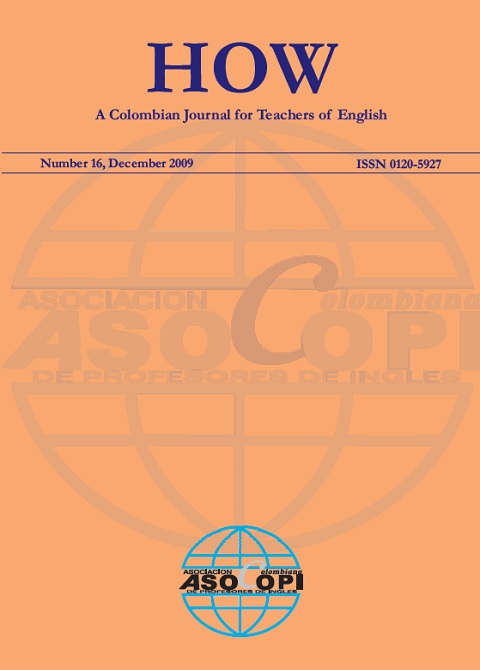Incremento de la comprensión lectora a través de estrategias de lectura utilizadas por un grupo de estudiantes de lengua extranjera
Contenido principal del artículo
Resumen
Detalles del artículo
Los contenidos de la revista HOW se publican bajo la licencia Creative Commons Atribución-NoComercial-SinDerivar 4.0 Internacional. Usted es libre para copiar y redistribuir el material en cualquier medio o formato siempre y cuando usted otorgue el crédito de manera apropiada. Usted no puede hacer uso del material con fines comerciales. Si usted mezcla, transforma o crea nuevo material a partir de esta obra, usted no podrá distribuir el material modificado. Más información: http://creativecommons.org/licenses/by-nc-nd/4.0/deed.es.
Se solicitará a los autores cuyos artículos se aceptan para publicación en HOW que firmen una cesión de derechos no exclusiva con el fin de permitir a ASOCOPI reproducir el texto completo en el internet o en cualquier otro medio disponible. Los autores conservan los derechos sobre sus manuscritos con las siguientes restricciones: el derecho de primera publicación es otorgado a ASOCOPI; los autores pueden establecer acuerdos no exclusivos con terceros siempre y cuando la publicación original en la revista HOW sea reconocida adecuadamente.
Citas
Baker, L. & Brown, A. L. (1984) Metacognitive skills and reading. In Pearson, D. (Ed). Handbook of reading research (pp. 353-394). New Jersey: Lawrence Erlbaum Associates, Inc.
Bensoussan, M. (1998). Schema effects in EFL reading comprehension. Journal of Research in Reading, 21(3), 213-227.
Bormuth, J. R. (1969) An operational definition of comprehension instruction. In Goodman, K.S. & Fleming, J.T. (Eds.), Psycholinguistics and the teaching ofreading. (pp. 48-60) Newark: International Reading Association.
Calfee, R. C. & Curley, R. (1984) Structures of prose in content areas. In Flood, J. (Ed.) Understanding reading comprehension: Cognition, language and the structure of prose (pp.161-180). Newark: International Reading Association.
Czico, C., Greenleaf, C., Hurwitz, L. & Schoenbach, R. (2000) What is reading? An excerpt from “Reading for Understanding”. The Quarterly, 22(3), Retrieved from http://www.nwp.org/cs/public/print/resource/787
Gascoigne, C. (2005). Toward an understanding of the relationship between L2 reading comprehension and grammatical competence. The Reading Matrix, 5(2), Retrieved from http://www.readingmatrix.com/articles/gascoigne/article.pdf
Hosenfeld, C. (1976) Discovering our students’ strategies. Foreign Language Annals, 9, 117-130.
Jones, R. C. (2007) ReadingQuest.Org. Strategies for reading comprehension. Comparison contrast chart. Retrieved from http://www.readingquest.org/strat/compare.html
Kucer, S.B. (2005). Dimensions of literacy: A conceptual base for teaching reading and writing in school setting, 2nd edition. Mahwah, NJ: Lawrence Erlbaum Association.
Ogle, D. (1986) ReadingQuest.Org. Strategies for reading comprehension. K.W.L. Retrieved from http://www.readingquest.org/strat/kwl.html
Palincsar, A. & Brown, A. L. (1984 – 1986). Reading quest.Org. strategies for reading comprehension. Reciprocal teaching. Retrieved from http://www.readingquest.org/strat/rt.html
Ruddell, R. B. & Unrau, N. J. (Eds.) (1994). Theoretical models and processes of reading. California: International Reading Association.
Sheng, He Ji (2000). A cognitive model for teaching reading comprehension. English Teaching Forum, 38(4).
Steffensen, M. S. & Joag-Dev, C. (1984). Cultural knowledge and reading. In Alderson, J.C. & Urquhart, A. H. (Eds.) Reading in a foreign language (pp. 48-61). London: Longman.
Urquhart, A. (1987) Reading in a foreign language: Comprehension and interpretations. Language Learning Journal. DOI: 10.1080/09571739285200101
Wang, S. & Han, S. (2001) Six C's of motivation. In Orey, M. (Ed.), Emerging perspectives on learning, teaching, and technology. Retrieved from http://www.coe.uga.edu/epltt/6csmotivation.htm.

